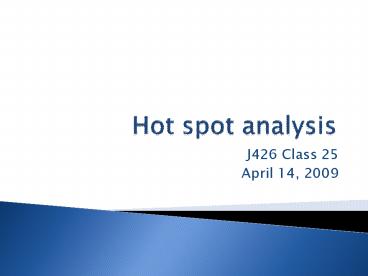Hot spot analysis - PowerPoint PPT Presentation
1 / 22
Title:
Hot spot analysis
Description:
Crime density maps are good for showing overall patterns of crime. Hot spot analysis shows smaller concentrations of large numbers of crimes ... – PowerPoint PPT presentation
Number of Views:654
Avg rating:3.0/5.0
Title: Hot spot analysis
1
Hot spot analysis
- J426 Class 25
- April 14, 2009
2
Overview
- Hot spot analysis and CrimeStat
- Nearest neighbor hierarchical clustering
- Spatial and Temporal Analysis of Crime
3
Hot spot analysis
- Crime density maps are good for showing overall
patterns of crime - Hot spot analysis shows smaller concentrations of
large numbers of crimes - Useful for making decisions on resource
allocation - Can do hot spots at different scales
4
Aggravated assault hot spots
5
Using CrimeStat for crime analysis
- CrimeStat is a standalone program that can do
many types of analyses with point data - Program developed with support of National
Institute of Justice - Program feely available for download on web
- Can use point shapefiles or tables with x- and
y-coordinates as inputs - Can generate outputs (such as the ellipses) as
shapefiles or tables with x- and y-coordinates,
depending upon analysis
6
Issues in creating hot spots
- Density maps vary with search radius, density
type - Hot spot analysis involve much more judgment,
creating very different results - CrimeStat includes numerous routines for hot spot
analysis - Routines have various parameters such as minimum
number of crimes per cluster and search radius - Also judgment on how results are displayed
7
Some types of hot spot analysis in CrimeStat
- Mode and fuzzy mode analysis
- Used to produce maps of multiple crimes at same
locations and crimes close to other crimes - Nearest neighborhood hierarchical clustering
- Spatial and temporal analysis of crime
- We will focus on these last two types
8
Nearest neighbor hierarchical clustering
- Combines points into cluster if distance less
than distance expected from random distribution,
using statistical test - Keeps as first-order hot spots clusters where
number of crimes greater than or equal to
specified minimum number
9
Nearest neighbor hierarchical clustering
(continued)
- Then treats those clusters as points, finds
second-order clusters that are clusters of
clusters - Displays hot spots using standard deviation
ellipses showing distribution of points (or
clusters) within the cluster
10
Nearest neighbor hot spots, minimum 10 crimes per
cluster
11
Nearest neighbor hot spots, minimum 15 crimes per
cluster
12
Size of standard deviation ellipses
- Clusters defined by points assigned to each
cluster - Display is via standard deviation ellipses for
those points, two dimensional spatial extensions
of standard deviation - Can create 1-, 1.5, or 2 standard deviation
ellipses - Smaller value gives smaller ellipses shows core
of cluster - Prior hot spot maps used 1.5 to make hot spots
more visible - Recommendation to more generally use the
1-standard deviation ellipses to focus on the
primary hot spot
13
Nearest Neighbor Hot Spots, Min 15, 1
1.5-StdDev Ellipses
14
Nearest Neighbor Hot Spots, 1 1.5-StdDev
(Zoomed in)
15
Statistical and Temporal Analysis of Crime (STAC)
- Developed by Illinois Criminal Justice
Information Authority - Lays out a grid over the area of the data
- Places circles at every node in the grid
- Counts the number of crimes within each circle
16
STAC (continued)
- Finds circles with greatest numbers of points
with at least 2 points (up to 25) - If point belongs to two circles, points in those
circles are combined - Displays hot spots using standard deviation
ellipses showing distribution of points (or
clusters) within the cluster
17
STAC hot spots, min 5 crimes per cluster, 0.5
mile radius
18
STAC hot spots, min 5 crimes per cluster, 0.25
mile radius
19
STAC hot spots, compare 0.5 and 0.25 mile radii
20
Comparison of nearest neighbor and STAC hot spots
21
Comparison of hot spots and density, radius 5,000
feet
22
Comparison of hot spots and density, radius 2,500
feet































